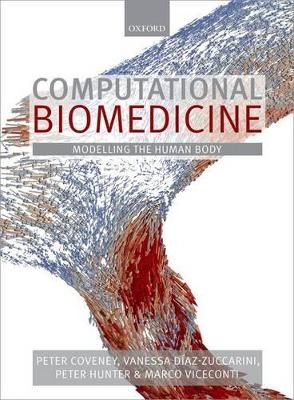
Computational Biomedicine
Oxford University Press (Verlag)
978-0-19-965818-3 (ISBN)
By the end of the twenty-first century, computer-based modelling and simulation will be integral to the way clinical decisions are taken. Drugs will be selected on the basis of an individual patient's "digital profile", while clinical treatments will be tailor-made for the individual in question. For this to come to pass, however, we must prepare for a future where we can simulate our own bodies with precision, drawing upon remarkable advances in information technology, computer, mathematical, physical and engineering science, data management, and high performance computing.
Computational Biomedicine lays the foundations for a new approach to the subject - one that unifies the different strands of a broad-ranging subject, and demonstrates how computational biomedicine is a powerful tool with the potential to revolutionise our understanding of the human body, and the therapeutic strategies available to maintain and protect it.
Written by a team of world-leading experts in the field, it explores the modelling of physiological systems at different scales - cells, tissues, organs - before considering the issues around biomedical computing, and data collection and analysis. It emphasises how a theoretical understanding of computational biomedicine translates into practice, with illustrative examples and case studies used throughout.
Computational Biomedicine is the perfect introduction to the subject for anyone new to the field, from student to researcher.
Online Resource Centre
The Online Resource Centre to accompany Computational Biomedicine features figures from the book in electronic format, for download by registered adopters.
Professor Peter Coveney, Centre for Computational Science, University College London Dr Vanessa Díaz-Zuccarini, Department of Mechanical Engineering, University College London Professor Peter Hunter, Auckland Bioengineering Institute, New Zealand Professor Marco Viceconti, Department of Mechanical Engineering , The University of Sheffield
1. Introduction ; 2. Molecular Foundations of Computational Bioscience ; 2.1 Introduction ; 2.2 Types of Omics Data ; 2.3 Databases and Data Sources ; 2.4 Management of Omics Data Types ; 2.5 Software Systems and Interoperability ; 2.6 Clinical Phenotypes, Security and Data Sharing ; 2.7 Conclusions ; 3. Understanding the Genotype-Phenotype Relationship ; 3.1 Introduction ; 3.2 Quantitative Genetics Theory ; 3.3 Systems Genetics ; 3.4 Implementing CGP Models ; 3.5 CGP Applications ; 3.6 Linking CGP Models to Data ; 3.7 Conclusions ; 4. Image Based Modelling ; 4.1 Introduction ; 4.2 Biomedical Imaging Techniques ; 4.3 Image Based Modelling ; 4.4 Medical Image Simulation ; 4.5 Statistical Atlases, Populational Imaging and Modelling ; 4.6 Open Source Image Modelling Tools ; 4.7 Conclusions ; 5. Modelling Cell Function ; 5.1 Introduction ; 5.2 General Cell Functions ; 5.3 Cell Fundamentals ; 5.4 Levels of Abstraction ; 5.5 Cell Simulation ; 5.6 Approaches to Modelling and Simulation ; 5.7 Simulation Tools ; 5.8 Example: An Agent Model in Skeletal Mechanobiology ; 5.9 Reproducible Modelling: Ordinary Differential Equations ; 5.10 Conclusions ; 6. Modelling Tissues and Organs ; 6.1 Introduction ; 6.2 Modelling Epithelia ; 6.3 Cardiac Modelling ; 6.4 Modelling the Gastro-Intestinal Tract ; 6.5 Modelling Kidney Function and Homeostasis ; 6.6 General Homeostasis and Blood Pressure Regulation ; 6.7 Conclusions ; 7. Multi-Scale Modelling ; 7.1 Introduction ; 7.2 Why Multi-Scale Modelling? ; 7.3 A Framework for Multi-Scale Modelling and Computing ; 7.4 Scale Bridging ; 7.5 Multi-Scale Computing ; 7.6 Example of a Multiscale Model: In-Stent Restenosis in Coronary Arteries ; 7.7 Conclusions ; 8. Workflows: Principles, Tools and Clinical Applications ; 8.1 Introduction: What is a Workflow? ; 8.2 Computational Workflows ; 8.3 Workflow Implementations ; 8.4 Provenance ; 8.5 Examples of Scientific Workflows ; 8.6 Key Considerations ; 8.7 Conclusions ; 9. Distributed Biomedical Computing ; 9.1 Introduction ; 9.2 Parallel Applications ; 9.3 The Computational Ecosystem ; 9.4 Computing Beyond the Desktop ; 9.5 Simulations in a High Performance Computing Environment ; 9.6 Case Study 1: Calculating Drug Binding Affinities ; 9.7 Computational Infrastructures ; 9.8 Distributed Applications ; 9.9 Orchestrated Workflows from Distributed Applications ; 9.10 Case Study 2: Computational Investigations of Cranial Haemodynamics ; 9.11 Conclusions ; 10. Managing Security and Privacy of Patient Data Sharing Platforms ; 10.1 Introduction ; 10.2 Legal Background ; 10.3 Brief Overview of Information Security Concepts ; 10.4 Common Data Sharing Requirements ; 10.5 The Data Sharing Lifecycle ; 10.6 Data Warehousing Architecture ; 10.7 Conclusions ; 11. Toward Clinical Deployment: Verification and Validation of Models ; 11.1 Introduction: Technology Assessment versus Health Assessment ; 11.2 Code and Model Verification ; 11.3 Sensitivity Analysis ; 11.4 Model Validation ; 11.5 Validation of Integrative Models ; 11.6 Clinical Accuracy ; 11.7 Efficacy, Risk and Cost-Benefit ; 11.8 Impact ; 11.9 Sustainability ; 11.10 Conclusions ; Appendix: Modelling Standards and Model Repositories ; A.1 Introduction ; A.2 Infrastructure for Computational Biomedicine ; A.3 Syntax, Semantics and Annotation of Models ; A.4 Markup Languages ; A.5 Model Repositories ; A.6 Conclusions
| Erscheint lt. Verlag | 24.6.2014 |
|---|---|
| Zusatzinfo | 210 illustrations |
| Verlagsort | Oxford |
| Sprache | englisch |
| Maße | 195 x 264 mm |
| Gewicht | 632 g |
| Themenwelt | Mathematik / Informatik ► Informatik ► Theorie / Studium |
| Medizin / Pharmazie ► Medizinische Fachgebiete ► Biomedizin | |
| ISBN-10 | 0-19-965818-8 / 0199658188 |
| ISBN-13 | 978-0-19-965818-3 / 9780199658183 |
| Zustand | Neuware |
| Haben Sie eine Frage zum Produkt? |
aus dem Bereich


